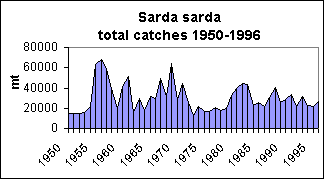
|
FAO Names |
En - Atlantic bonito; Fr - Bonito dos ray; Sp - Bonito atlntico. | |
Size |
 Maximum fork length in
the Black Sea is 85 cm and 5 kg weight; in the western
Atlantic, the largest fish caught is reported as
measuring 91.4 cm fork length and weighing 5.4 kg; common
to 50 cm fork length and about 2 kg weight. The
all-tackle angling record is a 7.6 kg fish with a fork
length of 78 cm taken in the Canary Islands in 1980.
Minimum length at first maturity is about 39.5 cm in
males and 40.5 cm in females. Maximum fork length in
the Black Sea is 85 cm and 5 kg weight; in the western
Atlantic, the largest fish caught is reported as
measuring 91.4 cm fork length and weighing 5.4 kg; common
to 50 cm fork length and about 2 kg weight. The
all-tackle angling record is a 7.6 kg fish with a fork
length of 78 cm taken in the Canary Islands in 1980.
Minimum length at first maturity is about 39.5 cm in
males and 40.5 cm in females. |
|
| Diagnostic Features |  Upper jaw teeth 16 to
26; lower jaw teeth 12 to 24; vomerine teeth sometimes
present; supramaxilla intermediate (Collette & Chao,
1975:fig. 32f); 16 to 23 gillrakers on first arch. First
dorsal fin with 20 to 23 spines, length of fin base 29.1
to 33% of fork length; dorsal finlets usually 8; 14 to 17
rays in anal fin; anal finlets usually 7; pectoral fin
rays 23 to 26, usually 24 on 25. Vertebrae 26 to 28
precaudal plus 23 to 27 caudal, total 50 to 55, more than
in any other species of Sarda. Colour: dorsal stripes
oblique, with a greater angle than in other species of
Sarda. Upper jaw teeth 16 to
26; lower jaw teeth 12 to 24; vomerine teeth sometimes
present; supramaxilla intermediate (Collette & Chao,
1975:fig. 32f); 16 to 23 gillrakers on first arch. First
dorsal fin with 20 to 23 spines, length of fin base 29.1
to 33% of fork length; dorsal finlets usually 8; 14 to 17
rays in anal fin; anal finlets usually 7; pectoral fin
rays 23 to 26, usually 24 on 25. Vertebrae 26 to 28
precaudal plus 23 to 27 caudal, total 50 to 55, more than
in any other species of Sarda. Colour: dorsal stripes
oblique, with a greater angle than in other species of
Sarda. |
|
| Geographical Distribution |  Tropical and temperate coasts of the Atlantic Ocean, including the Gulf of Mexico and the Mediterranean and Black seas (Collette & Chao, 1975:fig19. 70). In the western Atlantic, it has been taken at several localities along the outer coast of Nova Scotia but its usual northern limit is Cape Ann, Massachusetts. It is uncommon around southern Florida, present in the northern Gulf of Mexico, but apparently absent from most of the Caribbean Sea. It is known from Colombia and Venezuela and is much more common south of the Amazon River to northern Argentina. In the eastern Atlantic, it has been taken from near Oslo, Norway south to Port Elizabeth, South Africa. |